I wonder how many people would choose a temple filled with beady-eyed grey rats drinking milk out of rusty pans over the jewelry-making city of Jaipur? I guess it says a lot about Christine and I that we picked the former for our limited time in India – the main purpose of our out-of-the-way trip to Bikaner was to take a local bus 20km south again to the village of Deshnoak, to see the famous Rat Temple – more properly known as Karni Mata.
I’m getting ahead of myself – first there was the bus ride from Osian to Bikaner – what a ride. Rain started coming down in torrents before we reached Faloodi, a tiny backwater town that we didn’t see a whit of; just huddled under the awning at the bus stop. I gathered quite a crowd of gawking men around me, asking where I was from, where I was going, and why on earth I was here in Faloodi. People certainly stared at Christine, but societal norms meant that no one mustered the courage to try to talk with her – they saved that for me. I probably had 30 men ranging in age from middle school to a few elderly turbaned fellows by the time our bus to Bikaner arrived.
Everything was going fine – I had finished up that previous blog entry, and then started up a Shah Rukh Khan movie, “Om Shanti Om” with Christine on the tablet, when suddenly there was a loud WHAM, the bus swerved violently, and a hideous grinding, gasping sound filled the damp air. The bus wheezed to a halt on the side of the highway, which was mercifully between rain showers (but still sopping wet everywhere). Turns out the drive shaft powering the rear wheels had just plum fell off and was dangling like a black umbilical cord off of the bottom of the bus between the front wheels. There was nothing to do but drag out baggage off the bus, us and the 15 other Indians or so, and wait for the next hourly bus to Bikaner…and watch Om Shanti Om, to the delight of the Indians who clustered around behind us, pointing at the screen and jabbering away in Marwati or Hindi or something. It was better than constantly being asked questions about the trip that I’d answered dozens of times already!
The second bus was much less comfortable, although thankfully we boarded an hour later just as it started to rain and no one was carrying chickens under their arms. It was a tight squeeze – we fit Christine and I, plus our luggage, onto a seat that already had an old man and his luggage, and most of our fellow passengers fared about the same way. It was another hour to Bikaner, and the bus driver didn’t seem to have windshield wipers so he just poked his head out the side of the bus occasionally to make sure he wasn’t about to ram us into a placent cow, or an oil tank truck (in India, I’m not sure which would be worse for him).
Bikaner appears to be a city entirely without drainage system, and the streets were rivers almost a foot deep in most places. Rickshaw drivers were grimly chugging through on the edges, headlights flickering as the tiny lawnmower engines struggled through the shallower water. Our passengers disembarked into the river itself, hitching up their pants and wading to shore. When we finally reached the bus stop, we thought that we’d be scalped for rickshaw prices at 11pm in rain like this, and we would have been since everyone was asking for 100 rupees for a measly 1km ride, but a kindly young Indian couple invited us to share their rickshaw where they’d talked a driver down to 20r a head. It was a tight fit, too – there was a fifth guy as well, so the two Indian men kind of clung to the side of the front seat of the rickshaw, and then the woman, Christine, and I were stuffed into the back – plus our five bags of luggage. I’m surprised that the rickshaw didn’t sink like a ship, because we were definitely taking on water.
At last we finally made it to our hotel, the Jaswant Bhawan. We couldn’t believe the place was only 1000r a night for the two of us, it was quite nice, air conditioned, and even fairly spacious. It turned out that this was a kind of indirect homestay as well – the owner was the grandson of the former Prime Minister of Bikaner back when it had been a separate British state, and he had been one of the original signatories of the Indian Constitution in the 1940’s. The family still lived in a section of the house, but they had a dozen or so rooms to rent out to guests for a very good price, plus a restaurant which turned out to be the family’s own colonial-style dining room – at midnight, we were the only ones eating in it, but the man who had checked us in, the owner’s grandson, joined us for a bite (and told us the story of the place).
We awoke early the next morning, not sure of what would be the best way to reach Deshnoak and the temple – should we hire a car, take a train, or a bus to get the 20km south. The owners offered to call their private car to take us, but they would have charged 1000r for the day, and although we were literally across the street from the train station, we found out that there was only one train to and from the village all day. So we hoofed it a couple blocks to a traffic circle and caught a local bus for 20r each – not a bad deal. Once again, we were the subject of much interest on the bus – I hadn’t seen a single tourist in Bikaner yet. We sat in the back, surrounded by locals, and although I couldn’t tell precisely what they were saying, it seemed like they were trying to find a spokesmen since they kept saying snippets of English to each other, probably asking each other who best knew how to speak English to us. Finally, a journalist for a local newspaper who was also on the way to the temple for prayer was selected, and asked the usual questions, except he also wanted to know about my salary. I laughed and told him that he’d have to go first and tell me his – which ended up being 10,000r a month, or about $167 at current exchange rates. He didn’t seem surprised at the difference between monthly salaries, and agreed “government jobs like yours really are the best” (no one should tell him what server administrators in the private sector make, then) but seem horrified that a bottle of water would cost 120r when it cost 15r here.
The bus dropped us all off in a lot only a block from the Karni Mata – the temple seemed to be the entire reason for the village to exist, as the entire commercial area was built around it to tourist hunt. Christine and I felt kind of bad for the locals who must see tourists appear on buses (either dusty and local like ours, or massive air conditioned tanks for the tour groups) and then disappear only an hour later without spending any money – there really isn’t anything else of mention for tourism in Deshnoak but the temple. Here’s a link with better pictures, too.
And there, behind the huge carved doors to the temple, were the rats. Scurrying in and out of holes carved in the walls, lapping up milk from tins set out by monks, and sleeping in piles in the shade, were small, actually kind of cute rats. Not big and hideous “alley rats” and not quite as cute as white rats like a Westerner might own as a pet, but they seemed harmless and completely unconcerned by the crowds of tourists, mostly well-dressed Indians, taking photos of them. A large netting was thrown over the entire courtyard complex, probably to stop hawks from coming after the rats, and stop pigeons from eating the food reserved for the scampering little idols.
Christine hit on the possible reason why the rats were so respected by the temple goers – once again, a very Hindu mentality. “Maybe it’s because it takes more force of will to love or worship something that might inspire revulsion in you normally, kind of like loving your enemy. It’s good for your soul.” Inside the temple proper, away from the courtyard, people were coming in every few minutes and buying bags of seeds and nuts from monks for a few rupees apiece, then scattering them on the floor for the rats, who would eagerly run over and carry them off. In return, a monk would mark your forehead with orange paint – a sign that a devotee had been to the temple that day.
There were dead rats too, unfortunately – thankfully not in the middle of the floor where our bare feet could step on them and make them go squish. The cockroaches that scuttled in and out of the darkest corners of the temple seemed to be quite interested in them. Christine and I had each packed a pair of socks for the trip, specifically for this very day (we’ve worn sandals throughout the trip) but of course, we had both forgotten them back at the hotel. Stepping through rat or pigeon dung, or the thought of having an errant rat bite us or scratch us, was at the corner of our minds as we walked around, but we reassured each other that all the Indians were barefoot – if people were getting diseases from the temple, I’m sure there would be warning signs posted around the temple…right? Right? Please, India? Needless to say, as we departed, we were glad of the alcohol wipes that Christine had in her purse (she always keeps them on hand to wipe off her hands after petting friendly doggies, which she does at least a couple times each day).
We caught the same bus back to Bikaner (and the same journalist, now marked with orange paint, sat near us but was quiet this time) and had some time to kill in the city before our train left for Agra, so we headed deeper into the city and saw the Junagarh Fort, another large red stone fort placed in the middle of the city much like Jodhpur’s Mehrangarh massive palace that we had seen a couple days earlier. However, instead of a leisurely audio tour at our own pace this time, we had to join a Hindi-language tour group (which for our sake became a Hindi-English tour group) for the last tour of the day. Our guide was informative and did a good job switching smoothly into English when he saw Christine and I look at him, and the crowds of Indians that had probably paid only 10r versus our 150r seemed rather disinterested. But we were going to get our money’s worth, darn it, and enjoy the fort’s architecture, jewel and lacquered throne rooms, and massive audience halls! The guide seemed to be angling for a fat tip at the end, despite there being a huge sign at the end of the tour that said in English, “Please do not tip individual tour guides” so I had to disappoint him in the last wing of the palace, which despite being built in the late 14th century had had modern contrivances like an elevator and intercom phone system added to it (and also housed a WWI fighter plane given as a gift by the British crown for Bikaner’s assistance in the war). My thanks extend to Dr. Karni Singh, the last Maharaja of Bikaner, for donating the fort to the Indian Historical Society for us all to enjoy it.
On the way back to the hotel to pick up our bags, we stopped at an ATM withdraw a few thousand more rupees and as usual drew a crowd around us. This time though, people all seemed prepared to chat in English instead of silent stare at us as they had in the smaller towns – a father practically came up and pushed his 12 year old daughter to the front of the group and she said in very proper English “Hello, my parents would like me to practice my English, may I converse with you?” Meanwhile, a buff Indian man with slicked back hair was telling Christine about his future business plans and handing out business cards to her and every other man in the group surrounding us. I commented to the girl that she spoke English extremely well, better than many of the adults we’d met, and some guy behind me chimed in and said, “Well of course, we all studied English – every Indian should be able to speak as well as we can.” But I assured him that it had not been the case throughout much of our travels!
We got our bags from the Jaswant, bid our hosts the Singh family (again, no relation, just a common last name) farewell, and got to the train station with a comfortable margin of time. Our berths now, as we speed east toward Agra, are much tighter than the similar class of train that we had in Thailand to go from Chiang Mai to Bangkok, but of course this is India, a much more populous country. There there were four beds to a berth, here there are six – we’re packed in 3 to a wall which means that for Christine and I in the bottom bunks on the side, we definitely needed to be careful about smacking our heads on the middle bunks only a couple feet above us. Even so, we’re in 3rd class AC – and of the 20 cars in the train, only two are AC, the rest are all basically open-air plastic/metal seats. Indians are tough.
A friendly Indian solider named Anshuman and his wife and infant daughter have been our only berthmates so far (I assume that we’ll probably gain others elsewhere down the line), and Christine and I have been formally invited to their home in Varanassi the next time we’re in India if he can get leave at the time – he’s coming back from the Pakistan/India border right now to go back home for awhile, although for security reasons he couldn’t tell me where his base was – not that I would have recognized the name anyway, I’m sure! He and his wife seemed keen to know about when Christine and I were going to have children (for societal norms’ sake, we’ve been introducing ourselves as married to the average Indian) and our anniversary and when we met, so that they could compare it to their own – possibly some astrological compatibility thing, I couldn’t tell! Thankfully I had some numbers to give him off the top of my head and Christine played along; we’d never been questioned further before when people (frequently have) asked us if we were married! The Indian military seems like a good deal, even for a low-ranking artilleryman such as himself – he told us he’d been in the service for 12 years, and after only a few more he’d be able to retire from the service and get a pension for the rest of his life, although he figured he’d probably get a job back home in Varanassi just to make life more comfortable. When we told him that we were excited to see his city someday, he made a face and his wife laughed, and they exchanged glances. “Good for tourists, yes,” he said, “but not much opportunity or anything for the people that live there. But when you come to visit someday, perhaps you will see for yourself.” Mysterious! Well, next time we’re in India, it was definitely already on our list as it’s considered the religious crown jewel of the country with ancient temples and monuments and holy sites everywhere.
Well, I’d better get some sleep so I can post this from Agra tomorrow morning. If I go to sleep now, perhaps I won’t have to use the bathroom on an India train – Christine reports that it’s a hole that empties directly out onto the tracks below us. I’d better get the alcohol wipes for my feet from her just in case. Next stop, the fancy Oberoi Amarvilas hotel and the Taj Mahal! Won’t we look a sight to the hotel staff when we trundle in off the street.
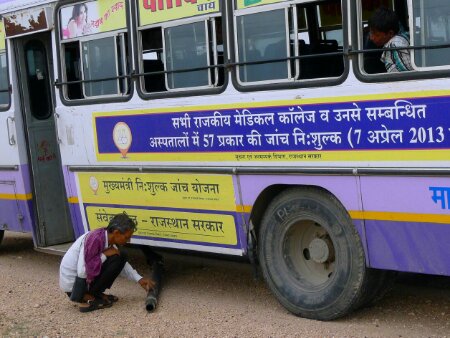



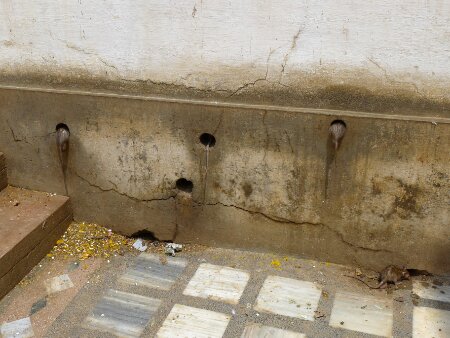
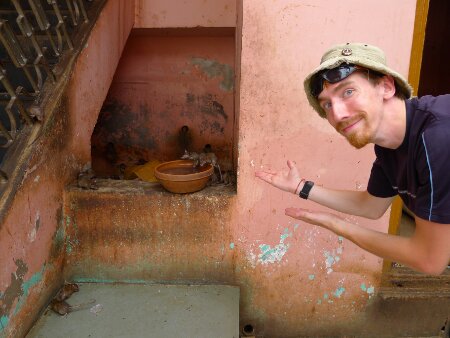
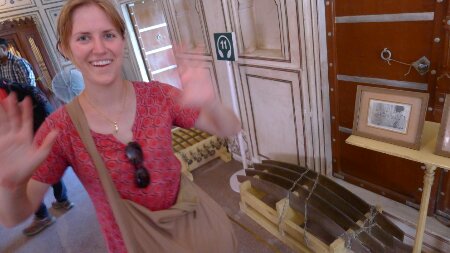
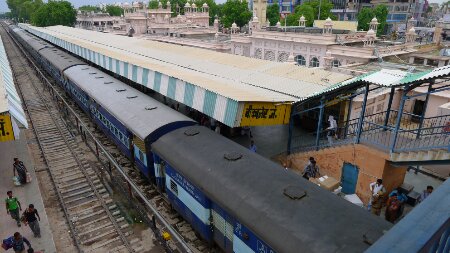


No one has commented on this post - please leave me one, I love getting feedback!
Follow this post's comments, or leave a Trackback from your site